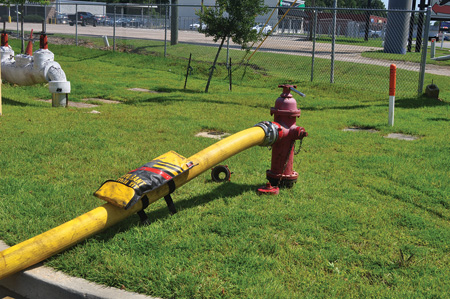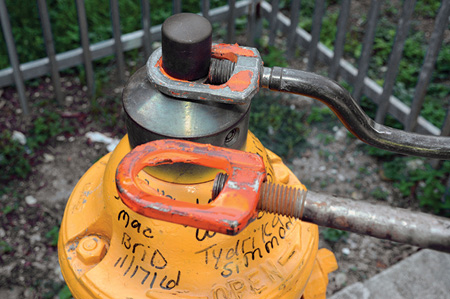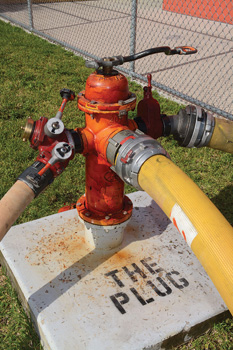
By Anthony Rowett
The most basic and most important engine company function on the fireground is getting water on the fire. To accomplish this mission and to ensure its continued success throughout the operation, the engine company must establish a water supply. There are multiple ways to do this; the most common method is to use a fire hydrant. When using a fire hydrant to establish a water supply during a fireground operation, the engine company attaches its supply hose to the fire hydrant and then to the apparatus and charges the hoselines using the water supplied by the hydrant. Firefighters can perform this routine task with minimal effort. When everything goes according to plan, the only tools and equipment needed to make the connection and perform the operation are the hose that will connect the fire hydrant to the pumper and a hydrant wrench. However, as we know, everything does not always go according to plan, and there are times when establishing the water supply connection will necessitate using more than hose and a wrench. At these times, a hydrant kit is needed to overcome the challenges interfering with getting a water supply in a timely manner.
Purpose of a Hydrant Kit
The hydrant kit contains tools and equipment used to make the hydrant connection. The container may be a toolbox or a bag. The kit generally is kept in a specific location on the apparatus and grabbed by the firefighter assigned to make the hydrant connection (hydrant firefighter) when he pulls the supply hoseline from the hosebed. In some departments, the kit (a bag containing the tools) may be attached to the supply hoseline so that when the hydrant firefighter pulls the supply hoseline from the hosebed, the kit automatically comes with the supply hoseline (photo 1). This helps ensure that any tools that are needed will be at the fire hydrant for immediate use if the hydrant firefighter must operate remotely from the apparatus.
 |
| (1) A hydrant tool kit attached to a charged large-diameter supply hoseline. (Photo by author.) |
If a hydrant kit is not used and the firefighter making the hydrant connection does not have a required tool, the firefighter will have to run to the engine apparatus wherever it is located and retrieve the needed tool before making the connection, thus negatively affecting all on the fireground. A hydrant kit is especially important during forward lay operations in which the engine arrives at the hydrant first and then lays the supply hoseline from the hydrant to the fire building. The hydrant firefighter must ensure that all the tools and equipment needed have been removed from the engine before signaling the apparatus to proceed to the fire building. The hydrant kit is useful anytime a hydrant connection is made. It is more important, though, for a forward lay than a reverse lay because during a forward lay the engine is not near the hydrant where the connection is being made. During a reverse lay, the engine is at the hydrant where the connection is being made; therefore, all of the tools and equipment contained on the apparatus will be available to the firefighter making the hydrant connection.
Contents of a Hydrant Kit
Hydrant kits include a variety of tools and equipment specific to the engine company to which the kit is assigned and its response area (photo 2). Some of the tools and equipment typically found in a hydrant kit include the following:
 |
| (2) A hydrant kit/bag. This bag contains two hydrant wrenches, one to operate the antitamper device and a ratchet wrench to operate hydrants next to walls or fences; two spanner wrenches; a 4-inch F × 4½-inch NST adapter; a pipe wrench for rounded pentagon nuts; a 2½-inch NSF × 5-inch storz adapter; 2½-inch caps; a 2½-inch gate valve; a 4½-inch NSF × 5-inch storz adapter, and a “T” handle wrench for operating wall hydrants. (Photos 2-4 by Eric Goodman.) |
-
Hydrant wrench. This tool may be used every time a hydrant connection is made. It is used to remove the hydrant cap so that the hose can be connected and the supply hoseline can be charged. Some fire hydrants may have antitampering devices that require specific hydrant wrenches (photo 3).

(3) Tools are employed to open a hydrant with an antitamper device. - Spanner wrench. Even though most hydrant wrenches can also be used as a spanner wrench, two standard size spanner wrenches should be included in the kits for tightening hose coupling connections so they do not leak. The second wrench will be needed when two hoselines are connected.
- Pipe wrench. A pipe wrench is an important tool that should be included in a hydrant tool kit. Civilians may operate fire hydrants for different reasons, and they use tools other than hydrant wrenches to turn the hydrant on and off. Many times, the tool they use can strip the operating nut on top of the hydrant. When this happens, the hydrant wrench no longer will be able to operate the fire hydrant; it will slip when turned because it does not have a tight fit on the operating nut. You will need to use a pipe wrench to get the hydrant to operate.
- Rubber mallet. It is important that a hydrant kit contain a rubber mallet that can be used to strike the lugs of the suction hose when connecting it to a hydrant’s steamer outlet.
- Wire brush. This tool may also be used every time a hydrant connection is made. It is used to clean the threads on the hydrant outlet if they are dirty.
- Double-male and double-female adapters. If the engine company uses three-inch supply line, the hydrant kit should also contain double-male and double-female adapters. These adapters can be useful if a problem arises when making the hydrant connection such as when a frozen female swivel coupling of the supply hoseline cannot be turned to make the connection to the hydrant outlet. The double-male adapter can be inserted into the female coupling of the supply hose and tightened and then the double-female adapter can be connected to the double-male adapter, which will allow a connection to be made to the hydrant outlet. It is also important that the hydrant tool kit include double-female adapters. When a hosebed is loaded in preparation for a reverse lay where the engine apparatus will arrive first at the fire building and then lay supply hoseline from the fire building to the hydrant, the male coupling is the first coupling off the apparatus. If the supply hoselines are loaded in the hosebed in preparation of a reverse lay but a forward lay is needed on the fireground, the double-female adapters will be used to connect each supply hoseline to the 2½-inch hydrant outlets that contain male threads.
- Hydrant-to-storz adapter. If large-diameter hose is used as the supply hoseline, the hydrant tool kit should contain a hydrant-to-storz adapter so the storz coupling of the supply hoseline can be connected to the threaded hydrant outlet.
-
Hydrant caps. Hydrant caps should be included in a hydrant tool kit so any missing caps on unused hydrant outlets can be replaced before placing the hydrant into operation, preventing water from flowing freely from the uncapped hydrant outlets.

(4) “Triple-tapping” a hydrant to maximize its flow. A wye and a gate valve are connected to 2½-inch outlets to facilitate connecting additional hoselines without interrupting the flow. - Valves. Since fire hydrants are designed to flow their maximum rated capacity when all of the hydrant outlets are flowing, many fire departments include valves in their hydrant kits. Valves allow the fire department to triple-tap the hydrant-use both of the hydrant’s 2½-inch outlets as well as the steamer outlet at the same time (photo 4). Before charging the supply hoseline, the initial arriving engine company connects ball valves, gated wye valves, or a water thief to each of the hydrant’s 2½-inch outlets. With these valves on the 2½-inch outlets of the hydrant, the hydrant can be charged and the large-diameter supply hoseline supplied with water first; later, the engine can also receive water from the hydrant’s 2½-inch outlets without interrupting the flow of water from the hydrant. Large-diameter supply hose is connected to the hydrant’s steamer outlet using a 4½-inch national standard female thread × five-inch storz adapter. Valves also make the hydrant an available water source for multiple responding apparatus if necessary. When valves are used during forward-lay evolutions, multiple engines can be supplied by the same hydrant. For example, the first-arriving engine company connects its large-diameter supply hoseline to the hydrant’s steamer outlet and connects valves to each of the hydrant’s 2½-inch outlets. This hydrant connection setup allows the first-arriving engine company to place the hydrant into operation and charge its large-diameter supply hoseline. Later during the operation, another engine apparatus can connect and charge its supply hoselines using the valves connected to the hydrant’s 2½-inch outlets without interrupting the flow of water from the hydrant and the first-arriving engine company’s water supply. When using valves to supply multiple apparatus during a forward-lay evolution, ensure that the combined flow of both engines does not exceed the hydrant’s flow capacity.
Standpipe Operations
Hydrant tool kits are also valuable when the engine must be connected to the fire department connection (FDC) to supply the standpipe system. You may encounter many of the same obstacles connecting to the FDC as to a hydrant and generally will need the hydrant wrench, the spanner wrenches, the double-male and double-female adapters, and the wire brush to resolve them. If the caps on the FDC are stuck and cannot be removed, the hydrant wrench can be used as a hammer to break the connection and loosen the caps. The rubber mallet can also be used for this purpose. Spanner wrenches are used to remove the caps from the FDC outlets as well as tighten the connection when hoselines are connected to the FDC outlet. Before connecting hoselines to an FDC, probe the outlets with a tool to ensure they do not contain any objects that may obstruct water flow through the standpipe system. Spanner wrenches are great for this task.
A primary use for double-male and double-female adapters is to connect hoselines to the FDC when the FDC’s female couplings are frozen or stuck and inoperable. Connect a double-male adapter to the inoperable female coupling and a double-female adapter to the double-male adapter. You may need a double-female adapter for the standpipe outlet and the hoseline (they both have male threads) if the FDC is inoperable and the supply hoseline must be connected to the standpipe outlet on the first floor of the building to supply water to the standpipe system.
Just as with hydrants, the FDC outlet threads may need to be cleaned before connecting the hoselines. The kit’s wire brush is the best tool for this task. The wire brush can also be used in place of the spanner wrench when probing inside of the FDC outlets for objects that may obstruct water flow.
Your department or fire company should determine in advance whether the hydrant firefighter will leave the kit at the hydrant or return it to the apparatus after completing the hydrant connection during forward-lay evolutions. Leaving the kit at the hydrant has the benefit of its being available at the conclusion of the incident when the hydrant is shut down. However, there is a possibility that the kit may be stolen if the hydrant is unattended.
ANTHONY ROWETT is a captain with the Mobile (AL) Fire Rescue Department. He previously was a volunteer firefighter with the Ogdensburg (NJ) Fire Department. He has an associate degree in fire science technology from County College of Morris (NJ), a bachelor’s degree in fire science, and a master’s degree in emergency services management from Columbia Southern University in Alabama. He has been published in Fire Engineering and Fire Rescue.
ESTABLISHING A WATER SUPPLY
OVERCOMING COMMON WATER SUPLY PROBLEMS
How Prepared Is Your Engine Company?

